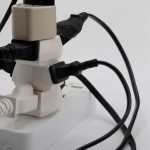Electromotive force, or EMF, is a fundamental concept in electrical circuits. EMF occurs when there is a potential difference between two points in a circuit, causing a flow of electrical current. This phenomenon is a crucial component of the functioning of electronic devices and power generation. In this article, we will explore the conditions under which EMF occurs in a circuit.
Contents
The Basics of EMF
Electromagnetic fields, or EMF, are a type of energy that surrounds us. They are created by the movement of electrically charged particles, such as electrons, protons, and ions. These fields are present in everyday life, from the electrical appliances we use to the natural radiation that comes from the sun and the earth.
Types of EMF
There are two main types of EMF: ionizing and non-ionizing. Ionizing EMF is the type of radiation that can cause damage to our cells and DNA, such as X-rays and gamma rays. Non-ionizing EMF is the type of radiation that is less powerful and does not have enough energy to cause damage to our cells. Examples of non-ionizing radiation include radio waves, microwaves, and infrared radiation.
Sources of EMF
EMF can come from a variety of sources, both natural and man-made. Natural sources include the sun, lightning, and the earth’s magnetic field. Man-made sources can include power lines, electrical appliances, and wireless communication devices such as cell phones and Wi-Fi routers.
The Effects of EMF on the Body
While non-ionizing EMF is generally considered safe, there is still some concern about its potential effects on the body. Some studies have suggested that exposure to high levels of non-ionizing radiation can lead to negative health effects, such as an increased risk of cancer, neurological disorders, and reproductive problems.
The Debate on EMF
There is still much debate among scientists and researchers about the potential dangers of EMF. Some studies have found no evidence of harm from exposure to non-ionizing radiation, while others have suggested a link between exposure and negative health effects. It is important to note that much of the research on EMF is still in its early stages, and more studies are needed to fully understand the potential risks and benefits of this type of radiation.
Protecting Yourself from EMF
If you are concerned about the potential effects of EMF, there are steps you can take to protect yourself. These include:
- Limiting your exposure to sources of non-ionizing radiation, such as cell phones and Wi-Fi routers
- Using shielding devices, such as EMF blocking cases for your cell phone
- Maintaining a safe distance from sources of non-ionizing radiation, such as power lines and electrical appliances
- Practicing good sleep hygiene, as EMF exposure has been linked to sleep disturbances
FAQs for the topic: when does emf occur
What is emf and when does it occur?
EMF stands for electromotive force. It is a potential difference or voltage generated in a closed circuit due to a magnetic field or a changing electric field. EMF is created when a conductor moves relative to a magnetic field, or when there is a change in magnetic flux linked with a conductor. As per Faraday’s law of electromagnetic induction, whenever there is a change in the magnetic field lines passing through a conductor, an EMF is induced in the conductor.
What are the sources of emf?
There are various sources of EMF, and the most common ones are generators and batteries. Generators produce EMF due to the rotation of a coil in a magnetic field. Batteries, on the other hand, generate EMF due to the reaction between chemicals in the battery. Other sources of EMF include motors and transformers, where a magnetic field is used to induce the EMF in a conducting coil.
When does an electric current flow through a conductor?
An electric current flows through a conductor when there is a potential difference or a voltage across its ends. When an EMF is induced in a conductor, it creates a potential difference that allows electrons to move through the circuit. Whenever there is a closed circuit with a conducting path, a potential difference is needed to allow electric current to flow.
What are the effects of emf on living organisms?
EMF has been linked to various health concerns, and some studies suggest that it may cause adverse effects on living organisms. The effects of EMF on living organisms can range from mild to severe, depending on the frequency and intensity of the EMF. Some of the commonly reported effects include headaches, mood swings, fatigue, and sleep disturbances. However, more research is needed to determine the extent and severity of the effects of EMF on living organisms.
How can emf be measured?
EMF can be measured using various instruments such as voltmeters, oscilloscopes, and electromagnetic field meters. These instruments are designed to measure the magnitude and direction of the EMF in a given area. The measurements can be taken in both AC and DC circuits, and the units of measurement for EMF are volts.
How can emf be reduced or eliminated?
EMF can be reduced or eliminated by taking various measures such as shielding, grounding, and avoiding exposure. Shielding involves using materials that block or reduce the amount of EMF that passes through a given area. Grounding involves creating a path of low resistance between the electrical device and the ground to reduce the amount of EMF. Avoiding exposure to EMF can also be achieved by limiting the use of electronic devices and living in an environment with low EMF exposure.


.jpg)
.jpg)



